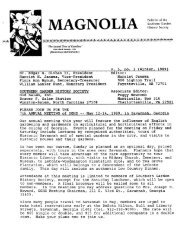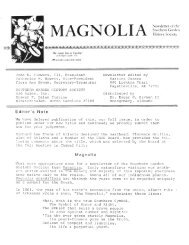Vol. XII, no. 2, 3 & 4 - Southern Garden History Society
Vol. XII, no. 2, 3 & 4 - Southern Garden History Society
Vol. XII, no. 2, 3 & 4 - Southern Garden History Society
You also want an ePaper? Increase the reach of your titles
YUMPU automatically turns print PDFs into web optimized ePapers that Google loves.
eighteenth–century layouts based on al<br />
sources available and from a k<strong>no</strong>wledge of<br />
eighteenth–century garden design . Brinkley<br />
believes that the few surviving portions of th e<br />
original layout that are still visible most likely<br />
indicate an eighteenth–century rectilinear garden<br />
style. The interior layout of this space is still open t o<br />
debate, however, the planting beds fit precisely into<br />
a sixty–foot by thirty–foot block with a tenfoot–wide,<br />
unk<strong>no</strong>wn area between the first and<br />
third blocks . Because the property remained in th e<br />
hands of Tucker's descendants until recently, and<br />
Shurcliffs existing conditions map of 1928 show s<br />
the site one–hundred and one years after the death<br />
of Tucker, Brinkley and I feel it is possible that<br />
some of the planting beds shown on the map were<br />
survivals from Tucker's original garden continuously<br />
maintained by his descendants. A number of<br />
examples of plants support this hypothesis .<br />
Brent Heath, a <strong>no</strong>ted bulb expert from<br />
Gloucester, Virginia, identified the bulbs<br />
photographed on the site during the spring of<br />
1994 and April through September 1995 .<br />
Narcissus varieties and cultivars include : `Red<br />
Guard' (1923), the species Narcissus poeticus<br />
radiiflorus, `Orange Cockade' (1938), `Avtaea'<br />
(pre–1927), `Sempre Avanti' (1938), `Emperor'<br />
(1890), and `White Lady' (1898) . These<br />
cultivars were likely planted prior to 1928<br />
because they correspond directly to th e<br />
planting beds <strong>no</strong>ted on Shurcliffs survey of<br />
existing conditions. They are probably also the<br />
ones that mark visible borders and cross–paths<br />
in the photographs. Several other old narcissus<br />
appear very near or just outside the areas<br />
planted prior to 1928. These are a Narcissus<br />
poeticus cv . (possibly `Ace of Diamonds' ,<br />
introduced in 1923), more `Orange Cockade' ,<br />
one identified as ` L 'In<strong>no</strong>cence' or `Laurens<br />
Koster' (1923), and `Limerick' (which is k<strong>no</strong>wn t o<br />
date prior to 1938 and is <strong>no</strong> longer in commerce . )<br />
Other old narcissus remain in the back garde n<br />
but do <strong>no</strong>t appear to be related to earlier planting<br />
beds. These could have been planted later or<br />
moved from a<strong>no</strong>ther location on the property. They<br />
include more `Orange Cockade' as well as `Empress '<br />
(from 1890 and <strong>no</strong> longer in commerce), `White<br />
Lady', `Aflame' (1938), `Elvira' (1904), `Damson '<br />
(1925), and `Emperor' (1890) .<br />
Tulipa sylvestris, a species tulip, appeared under<br />
the crape myrtle west of the central path and could<br />
relate to an earlier planting bed . The Leucojum and<br />
Ornithogalum nutans could also remain from an<br />
earlier planting since both were recorded i n<br />
England in 1594 . However, they were popula r<br />
for a number of centuries so they may relate<br />
to a later planting. Leucojum appeared in one<br />
of the photographs from the 1930s ,<br />
immediately after the house was re<strong>no</strong>vated, so i t<br />
would have been on the site prior to Shurcliff s<br />
plantings .<br />
Sterile bulb cultivars, such as the Narcissus, will<br />
perennialize and slowly form a larger clum p<br />
whereas plants that set seed can naturalize and will<br />
eventually cover areas much larger than th e<br />
intended planting . The species tulips that have <strong>no</strong>t<br />
bloomed have spread in this manner.<br />
Closer to the house, an area indicated on th e<br />
1928 existing conditions survey currently contains a<br />
white peony and an as yet unidentified plant . These<br />
two plants need further study to determine if they<br />
Computerized version of Arthur Shurcliffs on-site survey of<br />
existing conditions in 1928 .<br />
could have existed during the years Tucker<br />
gardened. I believe it is critical to preserve thes e<br />
plants for further study because of their location an d<br />
possible antiquity. Many clumps of bulb foliage<br />
never bloomed, while others may have bloomed in<br />
May prior to our photographs . Brent Heath<br />
suggested that the site be heavily fertilized in the fall<br />
to encourage the blooming of bulbs that may <strong>no</strong> t<br />
have done so in decades .<br />
A number of plants on Shurcliffs survey nee d<br />
further research . A climbing rose and mock orange<br />
appear in a clump that is <strong>no</strong>w overgrown wit h<br />
Japanese honeysuckle. The rose was indicated o n<br />
the map and mock orange was grown in America in<br />
7
















